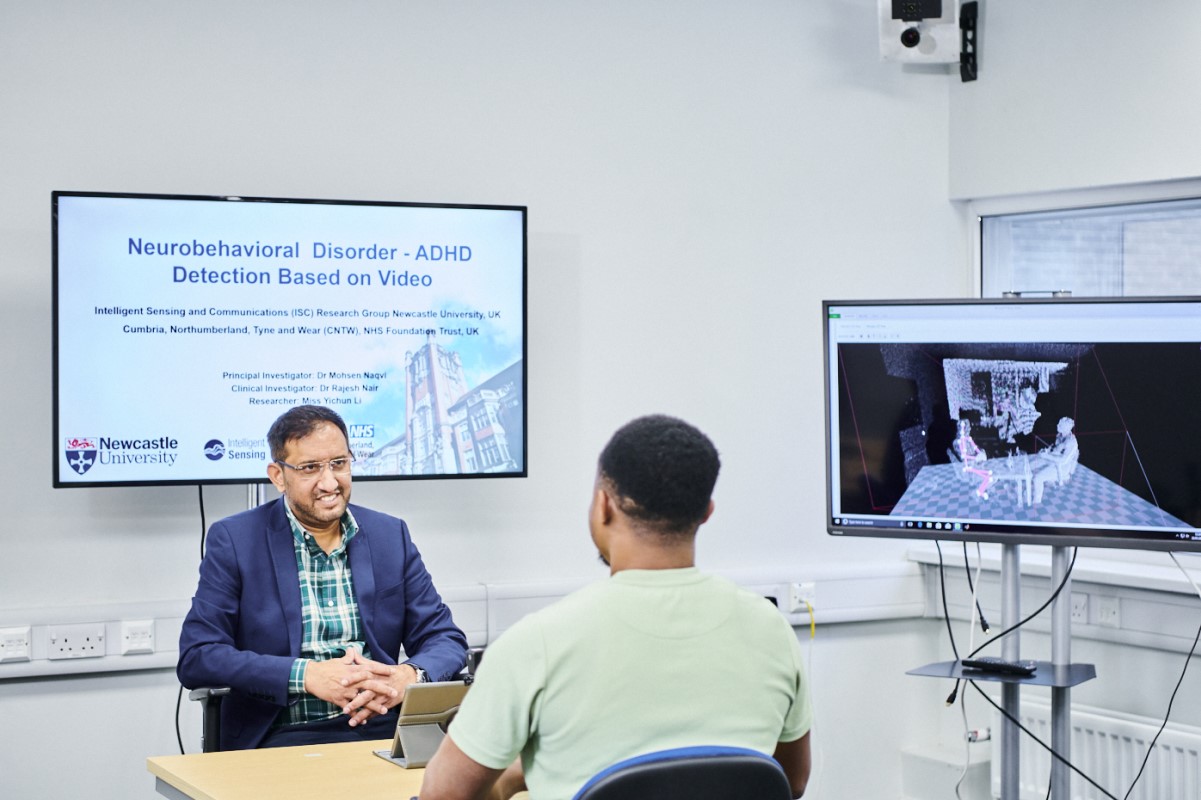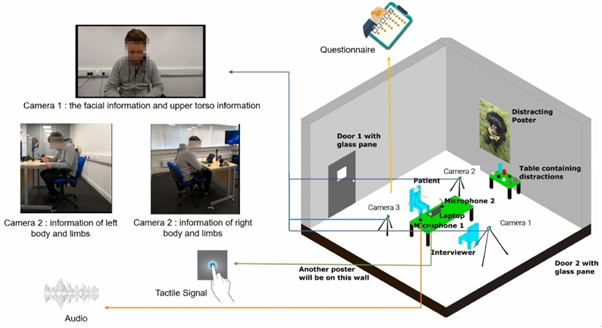The future of ADHD diagnosis, powered by Newcastle research and AI
22 March 2024 | By: Newcastle University | 2 min read
Researchers at Newcastle University are leading an interdisciplinary team to develop a machine that uses artificial intelligence (AI) to provide quick and accurate diagnosis of attention deficit hyperactivity disorder (ADHD).
ADHD affects 1.5 million adults in the UK. But only 120,000 are formally diagnosed [1]. It can affect everything from friendships to educational performance. In fact, people with ADHD have a higher risk of being involved in accidents, are more likely to have physical ailments like diabetes, and 40% of people with ADHD are likely to be unemployed [2].
Anything we can do to diagnose ADHD early could make a big difference to individuals – and could ease the burden on the NHS and social care systems.
Newcastle’s Dr Mohsen Naqvi leads a team of engineering and medical researchers working on Multimodal Data and Explainable AI (XAI). By analysing speech, text, and facial and body movements, they’re trying to achieve faster and more accurate diagnoses with measurable certainty.
Existing approaches are either too inaccurate or too expensive
Around 3% of adults and 7% of children suffer from ADHD. The mental health condition affects daily life for millions of people, but a formal diagnosis for adults can take seven years [3].
Traditional methods of diagnosis rely on the judgement of a psychologist. The process takes time and is prone to human error.
More modern methods use MRI scans, physiological tests or wearable sensors. However, these diagnosis methods are constrained by the high cost of the equipment and its operation, such as the referral, hospital or clinic appointment, and the dedicated staff required to perform tests e.g., MRI, fMRI scanners.
Is there another way?
Dr Naqvi and his team (along with collaborators within the Cumbria, Northumberland, Tyne and Wear NHS Foundation Trust including clinical investigator Dr Rajesh Nair) are approaching the problem from a new AI perspective.
Is it possible to develop an accurate system of detecting ADHD without expensive equipment or wearable/invasive sensors?
There are many observable symptoms of ADHD. For example:
- constantly fidgeting
- tapping with a pen
- fiddling with hair
- biting nails
- making careless mistakes
- not listening when directly spoken to
- losing things necessary for tasks
The XAI project involves gathering information through intelligent sensing to capture these symptoms and diagnose the condition.
A new multimodal data and AI approach
The intelligent sensing trial used a multimodal approach. The process assesses audio, video, medical notes, touch/keypad responses, and the answers on a diagnostic interview for ADHD (DIVA) questionnaire.
Patients start with a 10-20-minute interview. Then they’re asked to complete a professional test which takes around 40-50 minutes. Next is a beep reaction task which lasts up to six minutes. Finally, they watch a video for 10 minutes.
 Illustration of the trial setup, to capture multimodal real ADHD data. Credit: Intelligent Sensing and Communications Research Group.
Illustration of the trial setup, to capture multimodal real ADHD data. Credit: Intelligent Sensing and Communications Research Group.
As they complete these tasks, the patients are observed by three cameras and two microphones positioned around them. The room contains distracting posters and a table with distracting objects on it. Any observable ADHD symptoms they show – such as lapses in attention – are captured and measured.
These outputs are used to calculate the Attention Deficit Ratio which can then produce a diagnosis.
A promising trial
Demonstration video of the intelligent sensing trial. Credit: Intelligent Sensing and Communications Research Group.
The system detects ADHD through facial landmarks with an average accuracy of 88.24% (±3.93%). Audio signals result in an accuracy of 84.2%. And raw RGB videos result in an accuracy of 90.1%.
This system outperforms existing state-of-the-art methods. Other neural networks tested reach an accuracy of 76.4%, whereas the PoseC3D system used here achieves 88.2%. Precision, accuracy and AUC are all higher with this approach.
Just as importantly, the system is cost effective and easy to roll out across the NHS and beyond.
Ready to roll out
The initial trial involved 26 participants – 12 ADHD subjects and 14 controls. The resulting papers have achieved wide recognition:
- published in IEEE Journal of Translational Engineering in Health and Medicine 2024
- published in Neurology, Neurosurgery and Psychiatry 2023
- published in Neuroscience Applied 2023
- best paper at the 2023 International Conference on Sustainable Innovation
- best paper nomination at the 2023 International IEEE Sensors Conference
The promising early results are now ready to be scaled up. Dr Naqvi is applying for funding for a larger study and the team plans to develop a mobile version to make the system even more accessible to healthcare providers.
You might also like
- learn more about Dr Mohsen Naqvi, Reader in Signal Processing and AI and Deputy Head of Intelligent Sensing and Communications Research Group
- read about our electrical and electronic engineering research including our world-renowned research in advanced intelligent signal processing
- visit the Intelligent Sensing YouTube channel and watch a demonstration video of the trial
- explore the redeveloped Stephenson Building– a beacon for engineering education, research and collaboration
Footnotes
[1] https://pubmed.ncbi.nlm.nih.gov/25726514
[2] https://pubmed.ncbi.nlm.nih.gov/21846424
[3] https://www.bbc.co.uk/news/uk-england-44956540
